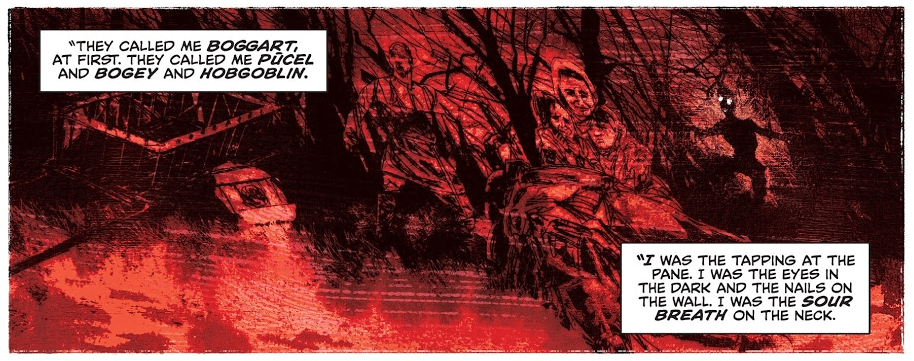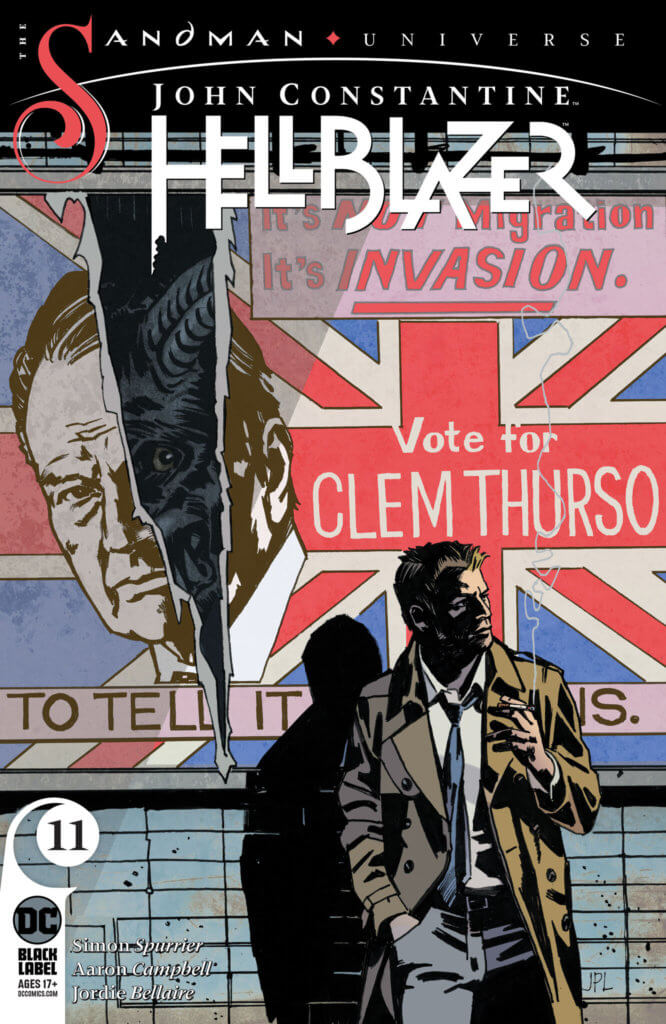John Constantine: Hellblazer is a nasty series. I mean that in the best way possible; I imagine it’s hard to be nasty in mainstream comics, where things are, above all else, meant to sell. But between unicorn semen and a vulgar metaphor made manifest in this penultimate issue, this series has been unrelentingly brash and audacious in a way that Hellblazer should be, in a way that’s refreshing to see from a big-two publisher, even relegated to their adult label.
John Constantine: Hellblazer #11
Jordie Bellaire (Colorist), Aditya Bidikar (Letterer), Aaron Campbell (Artist), Simon Spurrier (Writer)
DC Comics
October 28, 2020
Issue #11 opens with Constantine replaying a voicemail from Clem Thurso, the virulent racist member of parliament who’s been a hateful specter haunting the background of this series. Thurso has a bone to pick with Constantine, but this is a call for help—something he’s done has drawn someone’s ire, and he fears for his life. As it turns out, he’s a demon possessing Thurso’s body, but he’s witnessed something so horrible that even he, a literal demon, is repulsed. A literal demon isn’t the worst person in Parliament.
Thurso hasn’t always been a demon, but the man’s rise to power through stoking fear appealed to the demon that now possesses him. The distinction is important, because the issue makes it clear that Thurso was a racist piece of trash before the demonic influence. We can’t blame society’s ills on demonic influences—they are our problems to own and address.
In fact, writer Simon Spurrier made clear on Twitter that he and the rest of the team pulled some of Thurso’s racist dialog directly from Prime Minister Boris Johnson.
There's a page in Hellblazer #11 in which a British politician spouts a bunch of nakedly racist crap.
We had a conversation about whether we ought to tone it down — until I pointed out these are all things our literal actual elected serving Prime Minister has said.
— Simon "Si Spurrier" Spurrier (@sispurrier) October 30, 2020
As I’ve said throughout my reviews, the horror of this story—of pretty much every good Hellblazer story—is not the demons or the ghosts or whatever other nasties the team conjures up. It is, and always has been, the horrors of our own society: injustice, racism, poverty, Thatcherism, homophobia. Demons and the like may appear, but they feed on our excesses, they don’t create them.
The fun of Hellblazer is the fantasy elements. The horror is reality. Nowhere is this more clear than in this issue, where the two are blended together to make a political statement so explicit as to be frankly sickening to look at. It’s metaphor, not reality, but that makes the truth of it even more visceral.

This is, in no small part, thanks to the incredible combination of Aaron Campbell’s linework and Jordie Bellaire’s colors. It’s impossible to overstate how the artwork makes this story—Campbell’s linework is some of the most haunting I’ve seen in comics, full-stop, and Bellaire’s colors imbue it with a sick, terrifying life. It’s both beautiful and horrifying, a testament to both artists’ skills. The ending to the issue is the kind of thing that could work in prose in theory, but is made all the more impactful by being undeniably, disgustingly literal on the page. I don’t want to see it, but the John Constantine: Hellblazer team makes me. That is, in essence, what I hope for from all good Hellblazer stories—to be shown some undeniable ugliness, to see something triumph against it, and to be reminded firmly that the work is not done and will never be done.
Together, the team weaves a story that is terrifying, revolting, and prescient. Sure, there’s a demon involved, and that automatically makes the story a step (or several) removed from reality. But at its core, the issue raises questions of a nation’s ideals, the nature of power, the exploitation of fear and pride. It’s masterfully executed, and the crassness of it, the use of absolutely filthy and depraved imagery, makes it feel truly unique among current big-two comics. It’s not just what’s shown—though it’s that, too—but also the concept the art represents. It’s bold. It’s loud. It’s the artistic equivalent of grabbing someone by the shoulders and screaming in their face, bad breath, spittle, and all. I love every minute of it and will miss it when it’s gone.


